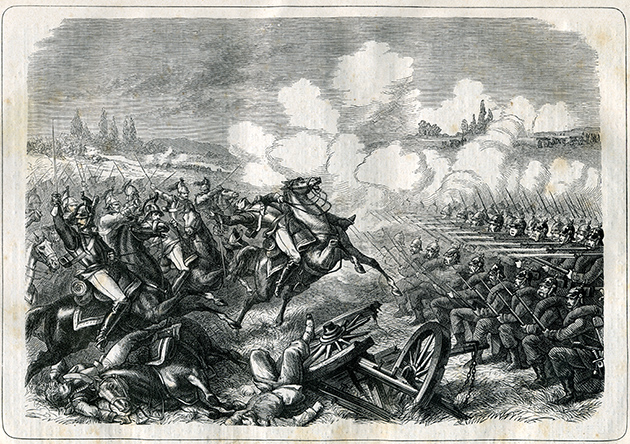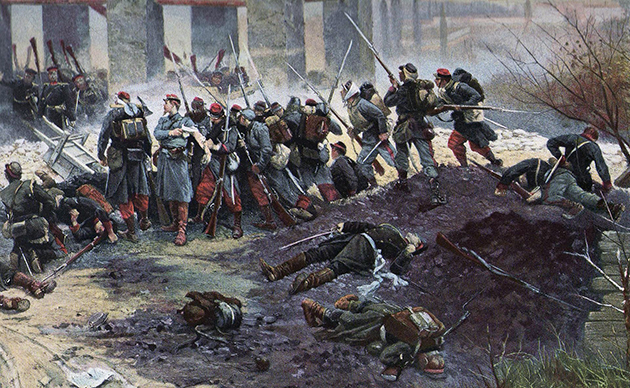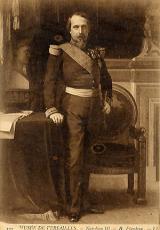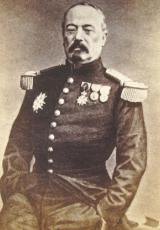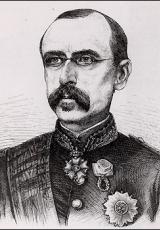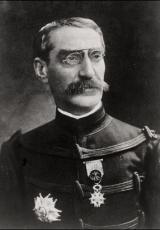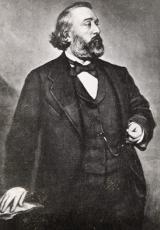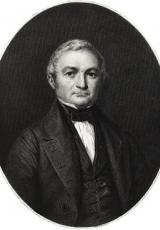The Franco-Prussian War, 1870-71

The Franco-Prussian War, between the German Confederation and France, lasted six months from 1870 to 1871. The immediate consequences for the belligerents were considerable: on the one hand, the fall of the Second French Empire, the civil war of the Commune and the advent of the Republic; on the other, the creation of the German Empire under the aegis of Prussia.
The declaration of war
The King of Prussia’s chancellor, Otto von Bismarck, set himself the goal of a unified Germany under his country’s authority: war against Denmark (1864), then Austria (1865), led to the incorporation of new states. Victory in a new war against France would cement the unity of the confederation once and for all, having taken advantage of Napoleon III’s diplomatic blunders to arouse anti-French sentiment. There was, to a lesser extent, a bellicose mood within the entourage of the French Empress, Eugénie, for whom a military victory – over Protestant Prussia, to boot – would consolidate the imperial prince’s position in the line of succession, in view of Napoleon III’s illness.
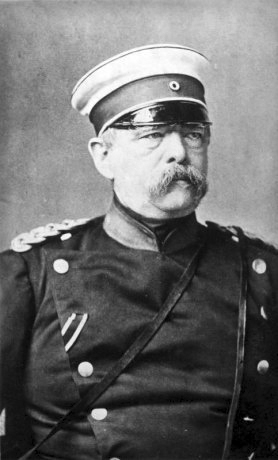
Otto von Bismarck. Source: German Federal Archives
The event which led directly to the conflict was the affair of the Spanish succession. In November 1869, the throne of Spain was vacant. The country’s provisional government offered it to a Prussian prince, Leopold de Hohenzollern, who asked King Wilhelm I for permission to reign. Wilhelm gave his consent in June 1870. Preparations then got under way in Spain for his coronation. But France became worried, for it would then have a Prussian presence to fear in the south as well as the east; it would be Charles V’s empire all over again, or at least that is what was claimed should be feared.
The French ambassador joined the King of Prussia in the spa town of Ems, where he was taking the waters. The negotiations proved successful: the king withdrew his agreement. As a result, the pretender to the throne renounced, on 12 July, and Spain officially notified Napoleon III. Thus, everything appeared to be to France’s satisfaction, but the French also sought assurances about the future, demanding that the Prussian pretender be permanently ruled out. The following day, Bismarck issued a garbled statement to German reporters: the famous Ems Dispatch. It claimed that France had made unacceptable proposals, which the king had rejected outright. The document was the spark that lit the powder keg. France felt its national honour had been offended, by the rebuffal of its ambassador, Benedetti. At the Chateau of Saint-Cloud, the French cabinet decided to wage war on Prussia. Special funds were passed by the French parliament, by 425 votes to 10. At 1 pm on 19 July, the French declaration of war was delivered to the Prussian foreign minister. Later that day, Wilhelm I made a speech in the Reichstag, appealing to the entire German people, whom France had gravely offended. On the 23rd, Napoleon III, after much hesitation, addressed a proclamation to his people, in which he denounced Prussia’s arrogance; then, on the 28th, in Metz, he took command of the army. On 2 August, the King of Prussia took charge of his troops, in Mainz.
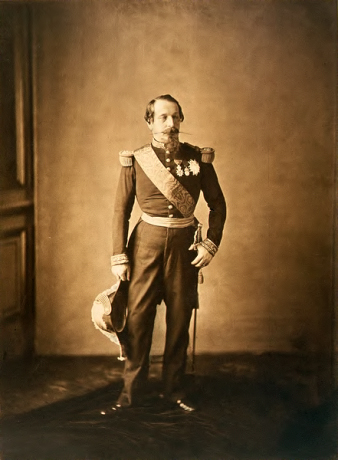
Napoleon III. Source: George Eastman House, Rochester, New York.
The military operations
The French army had barely 250 000 men, 43 000 horses and 900 field guns. It was undermined by a poor system of recruitment and mediocre commands, often ignorant of modern tactics; it had the first hand-operated machine guns (the De Reffye mitrailleuse) and an excellent rifle (the Chassepot), but weak artillery and ineffective logistics. The troops lacked neither courage nor devotion, however.
The enemy was a confederated army comprised of the royal troops of Prussia and 22 subject states of the North German Confederation, together with three other armies of southern states: the kingdoms of Bavaria and Wurtemberg and the Grand Duchy of Baden. The French were up against a considerable force, of approximately 600 000 men, 70 000 horses and 1 500 guns.
The first French soldier fell on 25 July in Alsace: Claude Pagnier, a non-commissioned officer in the 12th Chasseurs à Cheval light cavalry regiment, was killed in fighting against Baden dragoons, in an encounter between patrols in Schirlenhof (Bas-Rhin).
Charge of the French heavy cavalry at Froeschwiller, H. Merte, Alte und neue Welt. Illustrierte katholische Monatsschrift , 1871.
The war began with a series of defeats – Wissembourg, Forbach, Wörth, Beaumont, Sedan – culminating in the Emperor’s capitulation. In one tragic month, despite the heroic battles of Borny, Gravelotte and Saint-Privat, the army was destroyed, Napoleon III taken prisoner, Marshal Bazaine surrounded in Metz, and Strasbourg besieged.
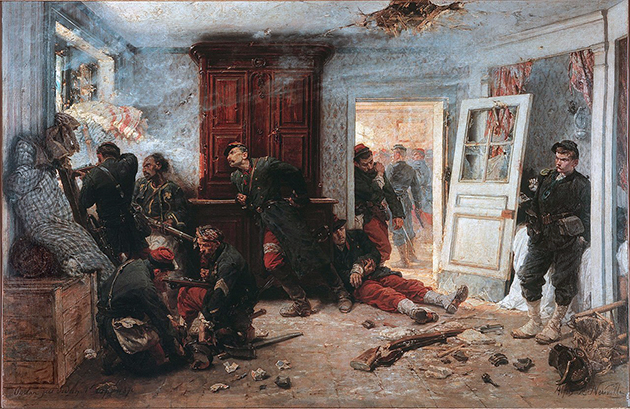
The Last Cartridges, Alphonse de Neuville, 1873. Maison de la Dernière Cartouche, Bazeilles
The Republic was proclaimed in Paris on 4 September. A Government of National Defence was formed, which took refuge successively in Tours then Bordeaux. It would carry on with the war in an attempt to hold on to the territory that had been invaded, to that end conscripting 600 000 men (regulars, Garde Mobile, francs-tireurs), buying weapons abroad and mobilising the navy in land operations and the defence of the capital.
On the 18th, at Ferrières, Bismarck rejected the peace proposals made by the French Republic, which resolved there and then to redouble the fight. Prussia was already laying claim to Alsace and Lorraine.
By the 19th, the enemy had overrun Paris, and began laying siege to the forts defended by General Trochu, who commanded a motley assortment of troops: the 35th and 42nd Infantry Regiments, Garde Nationale, marines, cavalry, sappers, artillerymen, volunteer francs-tireurs, a flotilla of armed steamers on the Seine, a battalion of Gardiens de la Paix, balloonists. He was assisted by General Chabaud-Latour and Admiral de La Roncière-Le Noury.
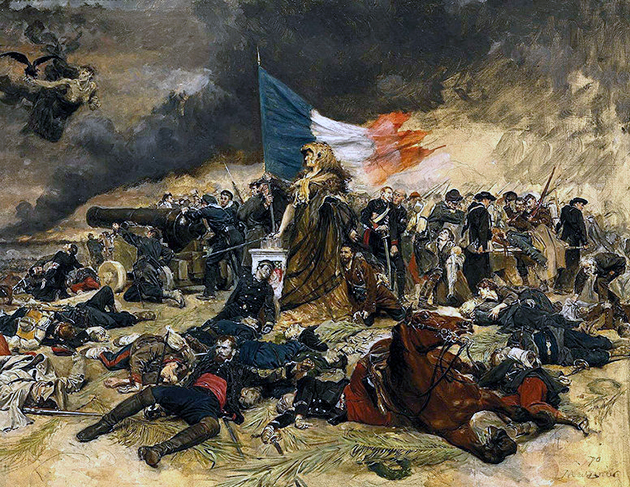
The Siege of Paris, Ernest Meissonier. Source: Histoire par l’image.
Strasbourg, bombarded, was taken on 25 September. Then an unprecedented catastrophe occurred: Bazaine surrendered at Metz, on 27 October, handing over 173 000 men, three field marshals, 50 generals, 53 flags and a vast quantity of weapons and ammunition – cannons, 200 000 rifles, 23 million cartridges – which the enemy would go on to use.
An Army of the Loire was formed in spite of it all. It fought some glorious battles at Artenay (10 October), Beaune-la-Rolande (28 November) and Patay (2 December), yet did not succeed in breaking the deadlock around Paris, where the besieged engaged in desperate fighting, without success: Le Bourget, Bagneux, Buzenval, Champigny. Orléans, however, was recaptured, following the victory at Coulmiers on 9 November.
A number of armies of the Government of National Defence, led by Léon Gambetta – who had escaped from Paris by balloon – tried to check the German advance, while the fortified towns of Belfort and Bitche continued to resist. The enemy recaptured Orléans. On 6 December, Rouen was occupied. The Army of the Loire was defeated at Le Mans on 10 January 1871. In Picardy, General Faidherbe was victorious at Pont-Noyelles (22 December) and Bapaume (2-3 January), but was defeated at Saint-Quentin, on 19 January.
A terrible winter overwhelmed the belligerents. The situation was appalling in Paris, ravaged by cold and famine. In the east, Bourbaki’s army, which had won the Battle of Villersexel (9 January) but lost that of Héricourt (16 January), was forced to take refuge in Switzerland. Italian patriot Garibaldi fought alongside the French at Nuits-Saint-Georges and Dijon.
Peace and occupation
Paris – bombarded, defeated at Champigny-sur-Marne – surrendered on 28 January 1871. An armistice was signed: the city must hand over its garrison and weapons, and pay an immediate ransom of 200 million francs in reparations to the victor.
Le four à chaux (detail). Fragment from La Bataille de Champigny, panoramic painting by Alphonse de Neuville and Édouard Detaille, 1882.
Source: Paris assiégé, Jules Claretie, 1898.
In the elections of 8 February, Adolphe Thiers won a majority and was elected chef du pouvoir exécutif (chief executive of the government), on the 12th, at the Bordeaux Assembly. He went to Versailles to negotiate with Bismarck who, on 18 January, had proclaimed Wilhelm I Emperor of Germany. On 26 February, a peace treaty was signed, establishing the general cessation of hostilities the following day. On 1 March, the Germans entered Paris from the west and marched down the Champs-Élysées.
On 27 March, the survivors of Bitche, in Moselle, left the citadel, flags unfurled, with the enemy’s military honours: since 8 August 1870, the town had withstood bombardment, famine and typhus, under the leadership of Commander Teyssier. Similarly, the defenders of Belfort had left the citadel as free men, on 16 January. On 18 March, an uprising broke out in Paris, known as the Commune: until 27 May, bloody fighting was to take place between “Versaillais” and “Communards”.
On 10 May 1871, the Treaty of Frankfurt put an end to this war which France had lost due to a lack of preparedness and unclear command of its army, deep political rivalries that influenced the course of the conflict, and its diplomatic isolation on the international stage.
France was forced to relinquish Alsace and part of Lorraine: close to 1 700 communes, with a population of 1.6 million. It held onto only Nancy, Toul, Verdun, and Belfort and area. This annexation led to large-scale migration to France and Algeria: between 1872 and 1885, tens of thousands of people left Alsace and Lorraine, replaced by 200 000 Germans. In addition, it had to pay Germany the colossal sum of five billion francs, plus 567 million in interest (most of this figure, astronomical for the time, was raised with the first national loan, on 27 June). To guarantee the payment, the German army would continue to occupy the country, only withdrawing from the departments as the instalments were paid. There would be no more French army north of the Loire, except one garrison in Paris until 1873.
These terrible peace terms had been agreed to by the National Assembly on 1 March, by 546 votes to 107. On 31 August 1871, Thiers became President of the Republic. As the staggered payments were made, the enemy gradually evacuated the departments. On 5 July 1873, it finally withdrew from the Ardennes, the Vosges, the Meuse and Meurthe-et-Moselle. Nancy was evacuated on 1 August, Belfort on the 2nd. Verdun was the last town to be held as a guarantee by the Germans. They left it slowly, on 13 September 1873, gathering just across the new border, near Jarny, ready to return.

The Prussians in Place de la Concorde, Paris, 1 March 1871. Source: La guerre de 1870 en images.
Over the two years following the signing of the peace treaty, it also fell to France to pay the costs of occupation, adding a further 341 million francs to its debts, to feed and house the occupier, who, meanwhile, proved a heavy burden for the population.
On 9 January 1873, Napoleon III died in exile, near London. On 24 May 1873, Marshal MacMahon was elected President of the Republic for a term of seven years, replacing Thiers. On 10 December, the Trianon war council sentenced Marshal Bazaine to death and reduction in rank, for “surrendering Metz without first exhausting his means of defence, without doing all that honour and duty required of him”. His sentence was commuted to 20 years’ imprisonment, by presidential pardon.
The war had been a bloody one, and actually caused greater devastation in the German ranks than on the French side. But the deaths of 138 000 Frenchmen were covered by the shroud of defeat.
France built tombs and monuments, and fervently commemorated their sacrifice, led by associations, politicians, artists (like Alphonse de Neuville and Édouard Detaille), veterans and school teachers. In this climate, a spirit of revenge would soon be kindled.
After the war, many veterans’ associations were founded, with their own flags, ceremonies and commemorative medals: on 12 July 1914, for instance, President Raymond Poincaré, on a visit to Picardy, presented a flag to the Roye veterans’ society.
In 1887, an Alsatian teacher, Xavier Niessen, founded Le Souvenir Français, to preserve the memory of those killed in the war and ensure the upkeep of their graves and memorials.
On 30 January 1914, Paul Déroulède died. The high priest of the revenge movement, Déroulède had enlisted as a volunteer in the 3rd Regiment of Zouaves in 1870, was taken prisoner in the Franco-Prussian War and went on to found the League of Patriots. In August 1914, when the French army attacked in Alsace, a German Empire border post pulled up on the road to Thann was carried triumphantly to Paris as a trophy and laid in homage on his grave in La Celle-Saint-Cloud cemetery.
Many generals in senior command positions in the First World War (Joffre, Foch, Pau, Gallieni, de Castelnau, Maunoury) were veterans of the Franco-Prussian War who, having suffered the experience of defeat, now experienced victory and the entry into Metz and Strasbourg (19 and 22 November 1918).
MINARM/SGA/DPMA
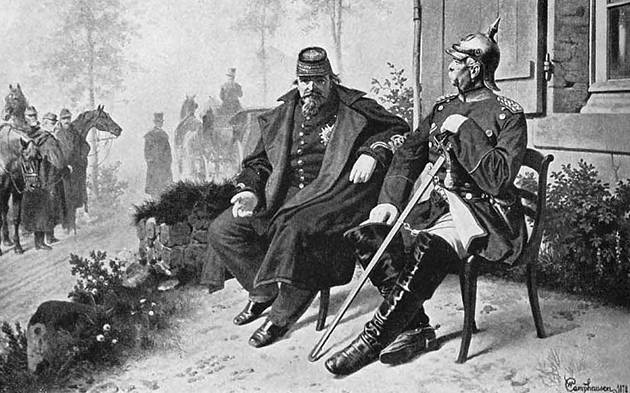
“Meeting between Napoleon III and Bismarck, on 2 September 1870 at Donchery, after the Battle of Sedan”, after Wilhelm Camphausen, 1878.
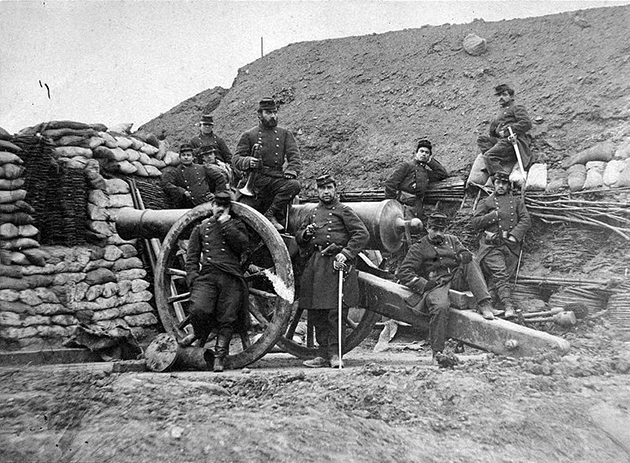
French soldiers during the Franco-Prussian War of 1870-71. Source: Brown University, Providence.
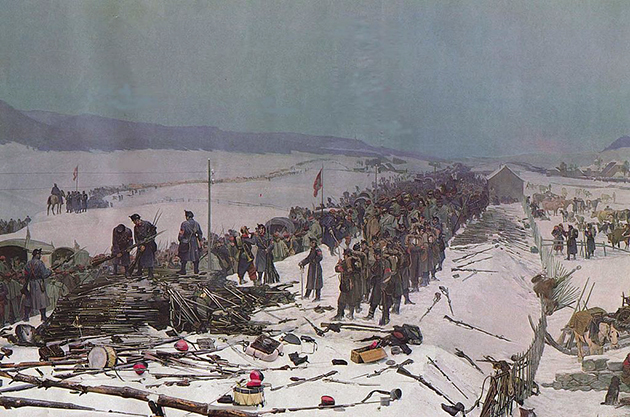
Section of the panoramic painting representing the Bourbaki Army in Switzerland, Édouard Castres, 1881-85. Musée de Lucerne.
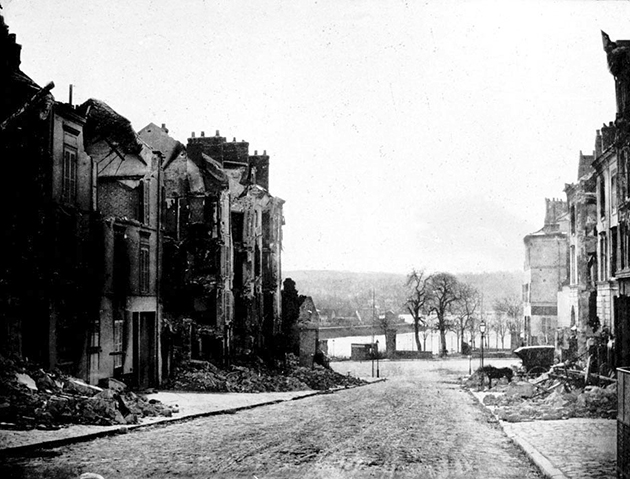
Saint-Cloud in ruins after the bombardments of the Franco-Prussian War. © ECPAD/Don Brocheton
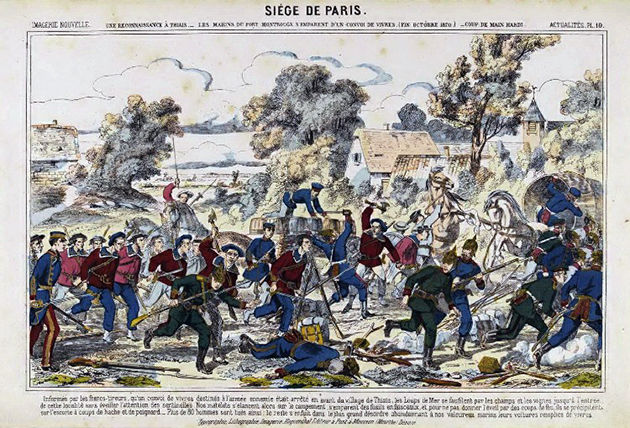
Épinal print: “The siege of Paris”. Source: La guerre de 1870 en images.
Saint-Quentin – The Prussians in the Grand’Place in 1871.
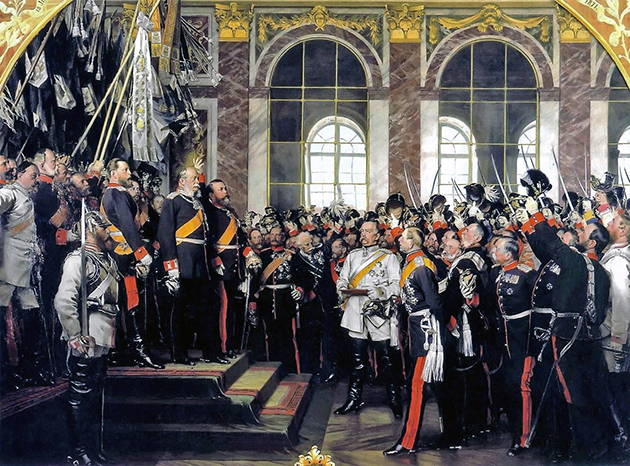
“Proclamation of the German Empire in the Hall of Mirrors of the Palace of Versailles, on 18 January 1871”, Anton von Werner, 1885. Bismarck-Museum
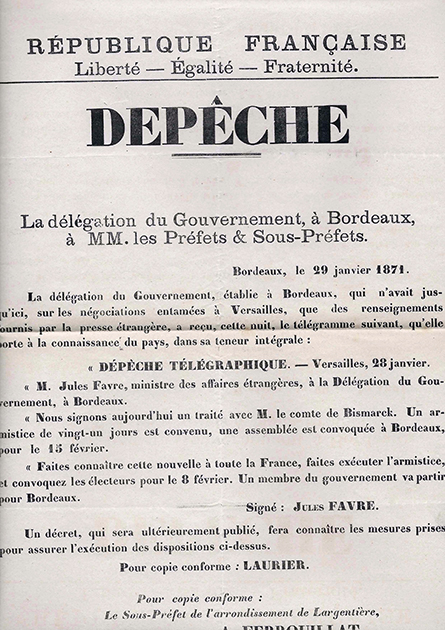
Dispatch announcing the armistice, Bordeaux, 29 January 1871.
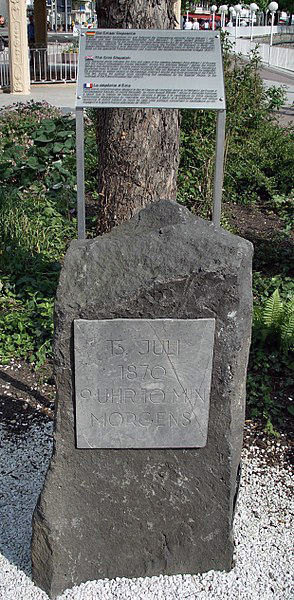
Memorial to the Ems Dispatch, Bad Ems (Germany). © Holger Weinandt


